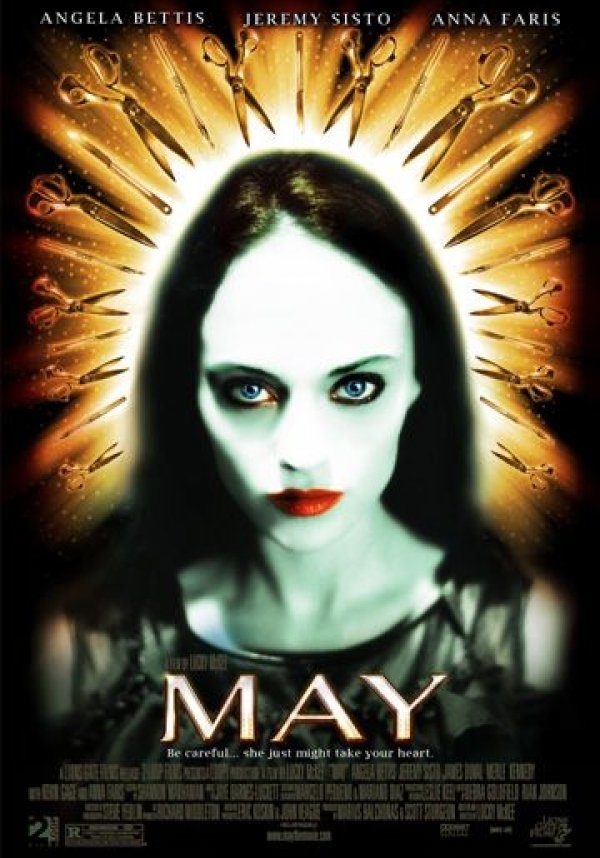“If you can’t find a friend, make one.” – The Disturbing Tale of May
In 2003, director Lucky McKee released “May,” a horror film that can be best described as a chilling tale about the deepest corners of loneliness and obsession. Imagine a cinematic journey that explores the intricate psyche of May Dove Canady, an awkward and peculiar young woman with a troubling childhood, played masterfully by Angela Bettis. Bereft of companionship save for a creepily enigmatic doll encased in glass, May’s search for love and connection spirals into sinister territories, threading a story so macabre yet deeply human at its core.
Macabre Mood and Gripping Tension
The horror in May doesn’t rely on traditional jump scares or ominous music to herald its arrival. Instead, an unrelenting sense of unease builds through the narrative’s progression. McKee’s approach seeps through the everyday banality pierced with disturbances that are genuinely unsettling. His manipulation of audience empathy constructs an anticipatory dread, knowing well that the character we grow to sympathize with is edging closer to abysmal choices. The film’s tone is less about the shock, and more about the haunting afterthought it installs long after the credits roll.
Lensed in Horror
The cinematography in May is nothing short of an auteur’s brushstroke, painting a picture that marries beauty and horror. The lighting ebbs and flows seamlessly with May’s mental state—color palettes shift from sterile whites that underscore her isolation, to saturated reds, emblematic of her eventual eruption of pent-up desires. Camera angles often skew to create a disorienting effect, adding to the sense of alienation May experiences. Moreover, the use of practical effects over CGI lends the film a visceral authenticity that modern horrors tend to lose in digital translation.
Sound becomes synonymous with silence in this film. The soundtrack, sparse yet effective, heightens every crunch and slice when it comes down to the raw horror elements. The silence itself becomes a weighty presence, making every bump and whisper a cause for heightened pulse. It’s an auditory element that understands its role perfectly—to amplify the horror when present and to haunt when absent.
The Fabric of Fright
Bettis’ portrayal of May is nothing short of remarkable. It could have been easy to overplay an outcast with such distinctive quirks, yet she imbues May with grounding vulnerability. The characters are well-developed, supported by commendable performances from Anna Faris and Jeremy Sisto, who become not only the foils but also the puzzle pieces to May’s deranged solution for connection.
The horror elements uniquely intertwine psychological, body, and to an extent, creature-feature horror. It defies being pigeonholed into a single subgenre, challenging viewers’ perceptions and pushing boundaries by transforming the protagonist simultaneously into the monstrosity and the victim.
May doesn’t rely solely on gore, although it has its fair share. The horror operates on a more psychological level, effectively leaving the audience unnerved by what this loneliness can metamorphose a person into. It’s the execution that’s particularly hair-raising, combining forethought with impulsive grotesquerie.
Cutting Deeper Than Skin
“May” is more than just a horror movie. It’s a commentary on the crushing pressure of isolation, the profound need for connection, and the lengths to which a person might go to create it. This undercurrent of societal commentary elevates the movie from a mere slasher-flick into the realms of thought-provoking horror.
The film’s effectiveness lies in its raw, unflinching gaze into May’s abyss, which reflects an unsettling truth about human fragility. It is frightening, indeed, but it is also melancholic, raising it above mindless terror into a realm of emotional disturbance.
Fans of psychological horrors and character-driven narratives will appreciate this film’s depth, though it may be too intense and graphic for casual viewers or those with a weaker stomach for horror. Its distinctive blend of unsettling character study and body horror puts it in the league with genre classics while standing out on its own.
The Final Cut
In summation, May slices through the superficial surface of horror, revealing layers of terror that are as human as they are horrific. Its strengths lie in its ability to weave empathy into the tapestry of horror, bolstering the frights with poignant psychological implications. Its few weaknesses might include moments where the pacing stumbles slightly, but these are far overshadowed by the film’s harrowing climax and aftermath.
“May” is a film for the horror connoisseur, for those who look beneath the blood to find the bleeding heart. Its graphic content and themes of self-harm are not to be taken lightly; viewer discretion is advised. In the vast necropolis of horror films, “May” stands as a headstone that marks the resting place of innocence, and the birthplace of a nightmarish friendship stitched together from the fragments of a broken heart.




